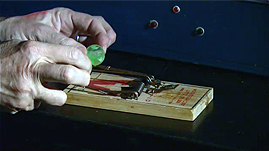Teachers' Domain - Digital Media for the Classroom and Professional Development
User: Preview


Source: QUEST: "Inside an Explosion"
Fission is a process by which a single neutron is absorbed by an atom, causing it to split into two fragments, releasing energy and free neutrons. The energy released from this interaction is far greater than the energy used to initiate the reaction, thus making the process highly enticing as a source of free energy for generating power that humans can use.
Fission was first observed in a German laboratory in 1938 when scientists were experimenting with neutrons and uranium. News of this discovery spread quickly, and by 1939, experiments in fission were taking place in the United States. Some say that this was the birth of the Nuclear Age.
Much of the excitement surrounding fission came from the fact that the process resulted in the release of massive amounts of energy relative to the energy used to trigger fission. Excitement intensified when scientists discovered that the neutrons resulting from fission could then be use to trigger more fission reactions, creating what is called a nuclear chain reaction, and releasing energy on a scale that was never seen before. The sun has naturally occurring fission reactions as a series of ongoing, nuclear chain reactions that generate tremendous amounts of heat and energy.
After the potential for energy generation on this scale was realized, research began in many different areas. During WWII, some researchers applied the concept of an uncontrolled nuclear chain reaction to develop a weapon—a “nuclear bomb.” However, research on the generation of energy for constructive civilian use also continued. This research aimed to develop a way to control and manipulate the chain reaction that occurs during and after fission.
Today, there are several nuclear power plants that exist in the United States and abroad. Each of these plants operates based on this principle of fission. However, there is a major drawback to using nuclear power. Many of the byproducts of fission leave behind radioactive material that is dangerous to humans and other organisms
To learn more about the process of fission, check out Nuclear Reaction: Fission, Fission and Reprocessing: How They Work, and Get Close to a Nuclear Fission Reaction!.
 Loading Standards
Loading Standards